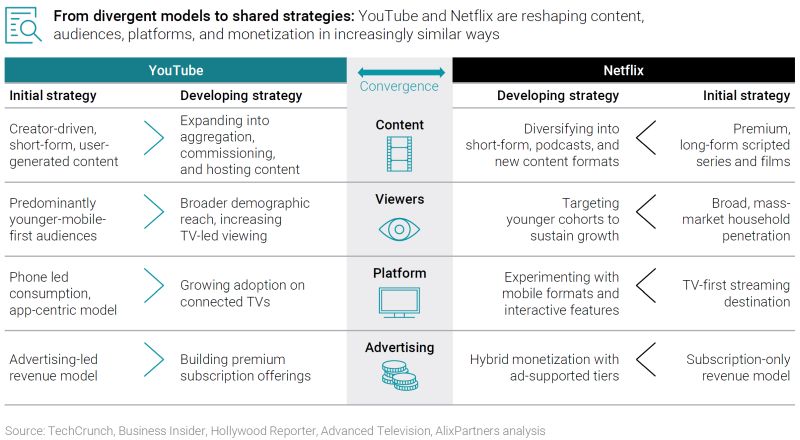- within Antitrust/Competition Law, Real Estate and Construction and Intellectual Property topic(s)
In 2026, we predict YouTube and Netflix will converge more than ever before as each vies to be the platform (and advertising partner) of choice for short-form creator content, serialized and episodic content, premium long-form entertainment, and live content. We predict that YouTube, the ad-revenue giant, will offer more Netflix-style content experiences to boost its subscriber base, while Netflix will increase its share of short-form, mobile-based content to rely less on subscription revenue and more on advertising.
In 1998, Netflix launched its online DVD service with 925 titles available for rental via mail. In 2005, YouTube—originally planned as an online dating service—launched as a video uploading and viewing platform with a clip of co-founder Jawed Karim at the zoo.
Fast-forward to 2025, and the two video behemoths have separated from the rest of the streaming field. Netflix is the world's largest subscription streaming service with more than 300 million subscribers, although in the U.S., YouTube's share of monthly television viewing now dwarfs Netflix's. They'll continue to battle for the top spot in global viewership and revenue for the foreseeable future.
As industry dynamics have evolved through the years, these two platforms with very different beginnings have grown in similar directions as market forces brought them closer together.
Key themes
The path to parallel offerings
YouTube and Netflix are converging across content, audience,
platform, and advertising to capture broader viewership. YouTube,
historically mobile-first, now sees televisions as the dominant
device in the U.S. and is expanding original scripted series,
episodic creator content, and pay-per-view movies, positioning
itself more like traditional TV streamers. Meanwhile, Netflix is
targeting YouTube's short-form dominance by moving into
creator-driven content and video podcasts, exemplified by its
partnership with Spotify for The Ringer's shows.
Both platforms are also adapting advertising strategies:
Netflix's ad-supported growth pushes YouTube to refine episodic
and shoppable ad offerings, while YouTube remains a major channel
for public broadcasters and IP owners to extend reach. Strategic
partnerships help Netflix reduce customer acquisition costs, while
YouTube continues to monetize at scale.
YouTube & Netflix: Different starting points to
converging strategies

YouTube and Netflix will reshape audience engagement
As the two platforms compete for top viewership and revenue,
their strategies—cross-format content, creator-driven
programming, and multi-platform distribution—are shaping
industry benchmarks.
From 2026 onwards, YouTube and Netflix will appear increasingly
similar in approach, dominating streaming for the foreseeable
future and setting the blueprint for how others attempt to
compete.
The content of this article is intended to provide a general guide to the subject matter. Specialist advice should be sought about your specific circumstances.



